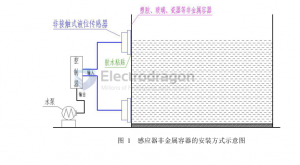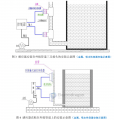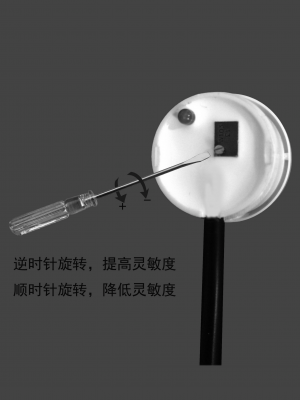ED25
product description
The intelligent non-contact liquid level sensor (hereinafter referred to as the liquid level sensor) adopts advanced signal processing technology and high-speed signal processing chip, which breaks through the influence of the container wall thickness and realizes the true non-contact of the liquid level in the closed container. Contact detection. The liquid level sensor (probe) is installed on the upper and lower sides of the outer wall of the container to be tested (the high and low levels of the liquid level). The non-metallic container does not need to be opened, and the installation is simple and does not affect production. It can detect the level of various toxic substances, strong acids, strong alkalis and various liquids in high-pressure airtight containers. The liquid level sensor has no special requirements for the material of the liquid medium and container, and can be widely used.
The intelligent non-contact liquid level sensor is divided into four signal output interfaces, namely high and low level input interface, NPN output interface, PNP output interface and RS485 communication interface; corresponding to the four models respectively:
- High and low level output interface —— Model: ED-Y25-V
- NPN/MC output interface —— Model: ED-Y25-NPN (5-12V), ED-Y25-NPN (24V)
- ED-Y25-MC (6-24V) (open collector output: active low)
- PNP switch output interface-model: ED-Y25-PNP (5-12V), ED-Y25-PNP (24V)
- RS485 communication output interface-model: ED-Y25-RS485 (24V)
Product features
- The non-contact liquid level sensor is suitable for the outer wall of non-metallic containers without direct contact with the liquid, will not be corroded by strong acids and alkalis and other corrosive liquids, and will not be affected by scale or other debris.
- Intelligent liquid level reference adjustment and liquid level memory function, liquid level status display mode, can realize multi-point series connection; support high and low level output, NPN, MC (define drive load such as relay, buzzer, electronic valve, etc. Load application), PNP signal output and RS485 communication interface output (please explain with the manufacturer when selecting the model).
- The detection is accurate and stable, and the boiling water level can be detected.
- Pure electronic circuit structure, non-mechanical working mode, stable performance and durability.
- High stability, high sensitivity, strong interference ability, free from external electromagnetic interference, special treatment for power frequency interference and common mode interference, to be compatible with all 5~24V power adapters on the market.
- Strong compatibility, penetrating various non-metallic containers, such as plastic, glass, ceramic and other containers, the sensing distance (container wall thickness) can reach 20mm; liquid, powder, and particulate matter can be detected.
- Open collector output mode, wide voltage range (5-12V) and 24V, suitable for connecting various circuits and product applications.
working principle
The intelligent non-contact liquid level sensor uses the inductive capacitance of water to detect whether there is liquid. When there is no liquid close to the sensor, the sensor has a certain static capacitance to the ground due to the distributed capacitance on the sensor. When the liquid level slowly rises and approaches the sensor, the parasitic capacitance of the liquid will be coupled to this static capacitance, making the capacitance value of the sensor larger, and the changed capacitance signal is then input to the control IC for signal conversion. The capacitance is converted into a change of a certain electrical signal, and then a certain algorithm is used to detect and judge the degree of this change. When the change exceeds a certain threshold, it is considered that the liquid level has reached the sensing point.
Product parameter
- ED-Y25-Y: 5-25V / H/L TTL
- ED-Y25-MC: 6-24V / Switch value (active low)
- ED-Y25-RS485: 24V(or 12V) / RS485
- ED-Y25-PNP: 5-12V or 24V / Switch value (active high)
- ED-Y25-NPN: 5-12V or 24V / Switch value (active low)
- Current consumption 5mA
- Response time 500mS
- Working environment temperature -5~100℃
- Humidity 5%~100%
- Induction thickness (sensitivity) range ≤20mm (container wall thickness)
- Liquid level error ±1.5mm
- Line length 500MM (±10MM) (bulk can be customized)
- Line end definition
- Brown (VCC), yellow (signal output)
- Blue (GND), black (signal selection terminal)
- Material ABS
- Waterproof performance IP67
- Safety standard certification CE
- Environmental certification ROHS-1.0
application conditions
Medium viscosity
Normal measurement when dynamic viscosity is less than 10mPaS. 10mPaS<dynamic viscosity<30mPaS may affect the detection. When the dynamic viscosity is >30mPaS, it cannot be measured because a large amount of liquid adheres to the container wall. Note: As the temperature increases, the viscosity decreases, and most high-viscosity liquids are more affected by temperature, so pay attention to the influence of liquid temperature when measuring viscous liquids.
Requirements and installation methods of the tested container
The tested containers are divided into 3 categories according to their materials:
The first category: insulating material container
Containers made of non-metallic materials with flat surface, uniform thickness, compact materials, and good insulation properties; such as glass, plastic, non-absorbent ceramics, acrylic, rubber and other materials or their composite materials.
- installation method:
- 1. If the container wall where the measuring probe is installed is of multi-layer material, the layers should be in close contact with each other without air bubbles or gas interlayers.
- The inner and outer surfaces of the container wall should be flat.
- 2. Wall thickness: 0-20mm
- 3. Tank type: spherical tank, horizontal tank, vertical tank, etc.
- 4. The installation method of this kind of material container is shown in Figure 1;
The probe can be fixed with glue or fixed on the outer wall of the container with a bracket. Try to avoid metal parts where the probe is installed, so as not to affect the detection. The place where the probe is installed should avoid the liquid inlet and the flow path of the liquid. There should be no silt or other debris in the container where the low-level probe is directly facing, so as not to affect the detection;
The second category: metal conductive material container
Containers made of metal or other conductive materials; such as stainless steel, copper, aluminum alloy or materials with electroplated metal layers on the surface. Because capacitive sensors are sensitive to all conductive objects, this type of container cannot be directly attached to the outer wall of the container; Therefore, for containers of this type of material, holes must be made on the side of the container. The installation method is as follows.
- installation method
- 1. Prepare two rubber plugs and the necessary tools for opening threaded holes;
- 2. Two threaded holes are opened in the high position and the low position respectively, and the hole diameter matches the size of the rubber plug;
- 3. Put a rubber plug on the threaded hole and tighten it to check for water leakage, and add glue to seal if necessary;
- 4. Paste the sensor on the rubber plug with glue and fix it with the bracket. After the glue has solidified, remove the bracket. The installation of the metal container is shown in Figure 2.
The third category: non-metallic materials that absorb water
Containers made of ceramics, tiles, bricks, tiles, cement, wood boards and other materials are themselves insulators or weakly conductive. This kind of container may not be detected when it is close to the liquid level sensor when it is dry and without water, but when the container is filled with water, the container wall will absorb water, causing the container wall to become a conductor; even if the container is empty When the sensor is close to the container wall, the signal will also be detected. If the sensor is to be used on a container of this type of material, the installation method should be in accordance with the installation method of a metal container. For the installation method, see "Class 2: Metal Conductive Material Container" and Figure 2; or use an external pipe to install. See Figure 3 and Figure 4.
Application Environment
1. ED-Y25-V, ED-Y25-NPN/PNP (5-12V)
It is only applicable under the conditions of good EMC environment. For example, the connection with MCU, and some simpler load applications, such as LED indicator light, piezoelectric buzzer, etc. And there is no high-power capacitive and inductive load and harsh electromagnetic environment on the power bus.
2. ED-Y25-NPN/PNP (24V), Y25-MC (6-24V), Y25-RS485 (24V)
This model is carefully designed for harsh industrial environments. Added professional EMC components Components, such as spike absorption, electromagnetic compatibility, and transient suppression and surge protection. It can be directly connected to PLC, electromagnetic relay, etc. It has a very strong anti-interference ability and is suitable for all harsh industrial application environments.
Output principle and wiring method
Sensitivity adjustment
Open the back cover of the sensor head, use a small screwdriver to adjust the sensitivity knob, turn it counterclockwise to increase the sensitivity, and turn it clockwise to decrease the sensitivity.








